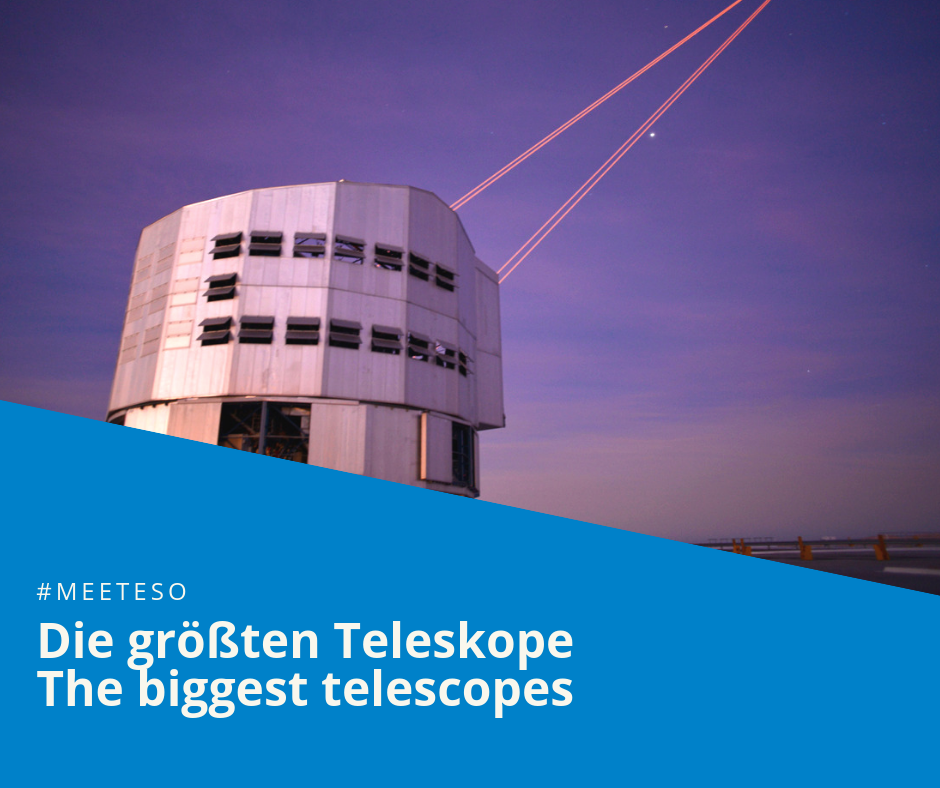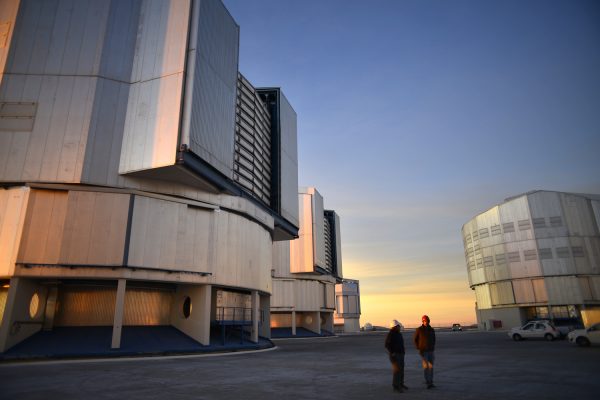2019
#MeetESO – the biggest telescopes on Earth

After an exciting day on La Silla and an amazing & beautiful solar eclipse we left the mountain to drive per bus through the night to Paranal. We arrived there in the early morning, in the middle of the Atacama Desert, after about an 8 hours’ drive. The distances are enormous here, as Chile covers from its Southern to its Northern point over 4,275 km (btw. from the Western to the Eastern point it’s only about 180 km)


On Cerro Paranal, at 2,600 m altitude, ESO’s currently biggest telescope, the Very Large Telescope (VLT) has its home. The VLT is not one big telescope, instead it consists of 4 UT’s (Unit Telescope), each equipped with an 8.2 m mirror. These telescopes can work together to have a bigger “mirror”. On Paranal there are also four smaller 1.8 m Auxiliary Telescopes. The method of connecting the telescopes is called interferometry and Paranal is one of the most advanced location using this technology. The main mirror of the UT’s is flexible and only 17.8 cm thick. Impressive isn’t it? To make such a mirror you need a special material, which was specially developed for astronomy. The material is called Zerodur and it consist of ceramic and glass
Did you know that nearly every household uses glass ceramic at home? It is used for our ceran cooking plates :-)
Zerodur is also known for the particular low thermal expansion. Moreover, the mirror is flexible and is shape is actively adjusted by about 150 actuators. This method is also called adaptive optics and was first tested with the New Technology Telescope (NTT). ESO has the most advanced adaptive optics mirrors worldwide.

The VLT has several instruments, with one of them it’s possible to observer an object in 3 different wavelengths (ultraviolet, visible light and near infrared) at the same time. The VLT is one of the most productive telescope sciences wise and discovers Exoplanets, observers the Black hole in the center of our galaxy and much more.
We visited the VLT during sun set. The warm light was beautifully reflected by the 4 UT’s on the platform. It’s really fantastic to see how ground-based astronomy is conducted here. This makes one a little bit speechless.


Not far from the VLT, only about 30 km airline on 3,060 m, is the biggest telescope of the world constructed. Equipped with security shoes, vest and helmet we got a first-hand look of the future telescope. And yes, the name Extremely Large Telescope (ELT) is well chosen. The thing will get enormous. In 2025 the building will be more than 60 m high and the mirror will have a diameter of about 40 meters. The dome doors alone, will weigh about 200 t per door. A special crane has to be shipped from Italy to Chile. At the moment there is “only” a big hole in the ground. More than 50 workers needed about 9 months to dig it. It is really hard to realize how big the dome will be, when it’s finished. But in 6 years from now this telescope will be a big milestone for optical telescope. I’m looking forward to its first light in 2025.


More Informationen:
https://www.eso.org/public/germany/teles-instr/paranal-observatory/vlt/
https://www.eso.org/public/germany/teles-instr/elt/
Dieser Artikel ist auch verfügbar auf: German
Events
Blog categories
- AMADEE-15 Simulation (13)
- AMADEE-18 (19)
- AMADEE-20 (21)
- AMADEE-24 (22)
- Aouda Spacesuit Simulator (67)
- ASE 2016 (9)
- Book tips (2)
- Events (32)
- Expeditions/Simulations (82)
- Flight projects (13)
- Guest blogs (14)
- Internships at the OeWF (57)
- OeWF internal (0)
- OeWF News (377)
- Phileas rover (21)
- Press Releases (41)
- Research/Projects (130)
- Serenity spacesuit (3)
- WBA 2025 (2)
- World Space Week (25)
